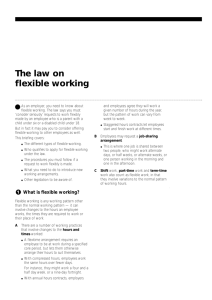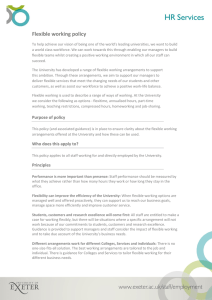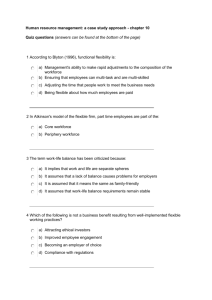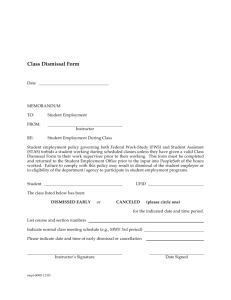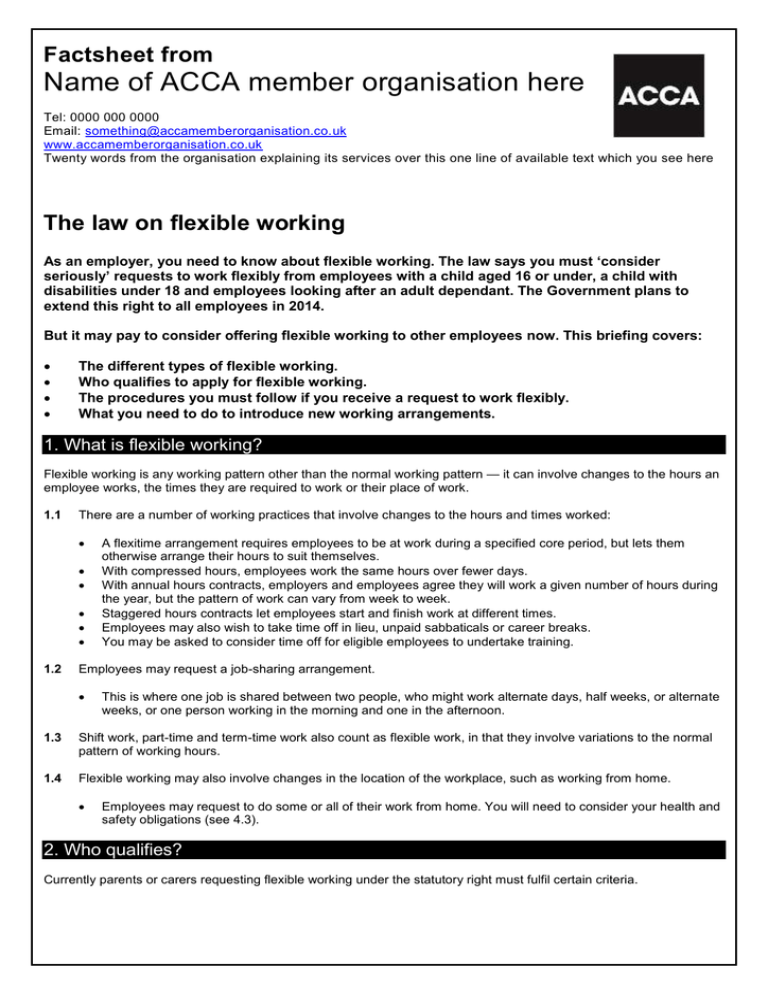
Factsheet from
Name of ACCA member organisation here
Tel: 0000 000 0000
Email: something@accamemberorganisation.co.uk
www.accamemberorganisation.co.uk
Twenty words from the organisation explaining its services over this one line of available text which you see here
The law on flexible working
As an employer, you need to know about flexible working. The law says you must ‘consider
seriously’ requests to work flexibly from employees with a child aged 16 or under, a child with
disabilities under 18 and employees looking after an adult dependant. The Government plans to
extend this right to all employees in 2014.
But it may pay to consider offering flexible working to other employees now. This briefing covers:
The different types of flexible working.
Who qualifies to apply for flexible working.
The procedures you must follow if you receive a request to work flexibly.
What you need to do to introduce new working arrangements.
1. What is flexible working?
Flexible working is any working pattern other than the normal working pattern — it can involve changes to the hours an
employee works, the times they are required to work or their place of work.
1.1
There are a number of working practices that involve changes to the hours and times worked:
1.2
A flexitime arrangement requires employees to be at work during a specified core period, but lets them
otherwise arrange their hours to suit themselves.
With compressed hours, employees work the same hours over fewer days.
With annual hours contracts, employers and employees agree they will work a given number of hours during
the year, but the pattern of work can vary from week to week.
Staggered hours contracts let employees start and finish work at different times.
Employees may also wish to take time off in lieu, unpaid sabbaticals or career breaks.
You may be asked to consider time off for eligible employees to undertake training.
Employees may request a job-sharing arrangement.
This is where one job is shared between two people, who might work alternate days, half weeks, or alternate
weeks, or one person working in the morning and one in the afternoon.
1.3
Shift work, part-time and term-time work also count as flexible work, in that they involve variations to the normal
pattern of working hours.
1.4
Flexible working may also involve changes in the location of the workplace, such as working from home.
Employees may request to do some or all of their work from home. You will need to consider your health and
safety obligations (see 4.3).
2. Who qualifies?
Currently parents or carers requesting flexible working under the statutory right must fulfil certain criteria.
2.1
The employee must:
Be the mother, father, adopter, guardian or foster parent of the child in question.
Be the spouse, partner, civil partner or relative, or live at the same address.
Have responsibility, or expect to have responsibility, for bringing up or caring for the adult or child.
Make the application as a means of enabling them to care for the child.
Have worked for you continuously for at least 26 weeks before making the application.
Have made no other application in the preceding 12 months.
Be willing to agree a change in their working pattern, with a corresponding drop in pay if necessary.
You can agree that it should only be a temporary or transitional change.
2.2
If the employee is requesting flexible working in order to look after a child, the child must be aged 16 or under, or
under 18 in the case of a child with disabilities.
The Government plans to extend the right to request flexible working to all employees with at least 26 weeks service.
This will not come into force until April 2014 at the earliest.
Note: Employees who have adopted ‘employee owner’ or ‘employee shareholder’ status under The Growth and
Infrastructure Act 2013 do not have the right to request flexible working. See margin note.
3. Implementation procedure
Under the law on flexible working, both sides are required to follow the correct procedure.
3.1
It is up to the employee to prepare a detailed application well in advance of when they want to change their
working pattern.
3.2
The application must be in writing and clearly state what the application is for and when it will be effective
from.
The employee should be able to come up with a clear plan of how the new pattern would work and must
show that the changes will not harm your business.
It must also explain how the employee feels he or she meets the relationship criteria.
It is good practice to acknowledge an application to work flexibly in writing. Once you have received an
application from an employee you must:
Arrange a meeting with the employee within 28 days of receiving it.
This is to decide a start date (if you agree), or to consider alternatives (if you do not).
The employee has the right to be accompanied at the meeting. The companion must be a worker also employed
by you.
If you agree, write to the employee within 14 days of the meeting detailing the new working pattern and
confirming the start date.
If you do not agree, you must write to the employee within 14 days with business reasons why the proposed
arrangement will not work.
You must date your refusal and set out your appeals procedure.
3.3
You can refuse an application to work flexibly only if there is a clear business reason.
Valid reasons as set out in the legislation are:
The burden of additional costs.
A detrimental effect on the ability to meet customer demand.
An inability to reorganise work among other employees.
An inability to recruit additional employees.
2
3.4
A detrimental effect on quality.
A detrimental effect on performance.
Insufficient work when the employee proposes to work.
Planned structural changes.
If you refuse an application to work flexibly, the employee may appeal.
They must write to do so within 14 days of you sending your letter of refusal.
You must have an appeal meeting within 14 days of receiving this letter.
You must write, accepting or refusing the appeal, within 14 days of this meeting.
3.5
If you still refuse the application, and the employee feels that their application has not been considered seriously,
they may want to take further steps.
Try to deal with the problem internally at this stage. An informal discussion between you and the employee
may clear up any misunderstandings.
Or, encourage them to use a formal grievance procedure. It will also be much quicker than involving external
parties.
If it is still not possible to resolve the dispute, the employee may decide to involve an external third party.
This might be someone from Acas or some other mediator or conciliator.
They will try to resolve the problem in an informal manner by mediating discussions between you and the
employee.
3.6
In some circumstances, the employee may decide to make a formal complaint to an employment tribunal or to
the Acas arbitration scheme.
The employee can only do this if you have failed to follow the correct procedures, if your decision was based
on incorrect facts, or, perhaps, if the employee is caring for a disabled relative, and the employee claims the
refusal amounts to disability discrimination.
If it is shown that you have not followed the correct procedure, you will have to reconsider the application.
You may also have to pay compensation to the employee.
The amount payable will be decided by the employment tribunal or the Acas arbitrator and will be limited to a
maximum of eight weeks’ pay. Each week’s pay is currently limited to £450. If a discrimination claim succeeds,
compensation is not capped.
3.7
The timescales may be extended by mutual (written) agreement. If the employee fails to attend two or more
meetings (without a reasonable explanation), you may treat the application as withdrawn.
3.8
The current statutory procedure will be removed when the right to flexible working is extended to all employees.
Employers will have a duty to consider all requests in a reasonable manner.
They will retain the right to refuse requests on business grounds.
4. Moving into flexible working
Once you have accepted a request for flexible working you may need to make some changes.
4.1
You will need to amend the employee’s contract of employment.
4.2
You may want to agree a trial period.
If the new arrangement changes the number of hours worked, you will need to amend the employee’s pay and
holiday entitlement.
3
4.3
If the employee will be working from home, health and safety requirements will still apply.
An initial risk assessment must be carried out although this can be done by the employee. Areas to consider are:
The seating and layout of the employee’s computer workstation.
Electrical equipment. Has it been tested and certified?
Make sure there are no trailing extension leads.
Adequate lighting levels, ventilation and room temperature.
Give employees simple, specific health and safety advice and record what has been done.
4.4
Consider the impact of the changes on other employees.
4.5
If an employee will be working fewer hours, make sure you have adequate cover in place. Other employees
may become resentful if their workload increases.
You should inform other employees as early as possible.
You also need to make sure work is allocated fairly. For example, in a job share you need to make sure that
both parties have equal responsibilities.
Make sure you are consistent in your approach. Keep records of who has applied to work flexibly, and what your
response was. Monitor and evaluate how the new arrangements are working so you can put changes in place if
necessary.
5. Other legislation
In general, the same legislation applies to employers offering flexible working patterns as to those adopting more
conventional arrangements.
You should also take account of some specific protection for employees working flexibly.
5.1
The employee is protected against dismissal or constructive dismissal under the flexible working rights. It is
unlawful to dismiss an employee because:
5.2
If you are making employees redundant, make sure this has nothing to do with their right to work flexibly.
5.3
They have applied to work flexibly and it has been granted.
They have made or intend to make a complaint to an employment tribunal.
In such a case, the 12-month qualifying period of employment is waived and dismissal will be classed as
automatically unfair.
Employees are protected from dismissal on these grounds.
When implementing flexible working arrangements you will need to make sure you are not discriminating against
the employees concerned.
Fixed term and part-time employees are legally entitled to be treated ‘no less favourably’ than their
permanent, full-time colleagues.
If you place a requirement on an employee to work full time, the employee may be able to make a claim
against you for indirect discrimination under the Equality Act 2010.
If the employee is caring for a disabled relative, the refusal may amount to disability discrimination. There is no
ceiling on the amount of compensation that can be awarded in such cases.
5.4
People who work on annual hours or term-time contracts are protected by the working time and minimum wage
regulations, just like full-time employees.
6. Further help
4
6.1
Acas has a good guide to forms of flexible working, plus an advice leaflet and various forms on its website at
www.acas.org.uk or for further advice call 08457 47 47 47.
6.2
Visit www.gov.uk/flexible-workingfor an interactive guide to flexible working rights.
Business benefits
Although you only have a legal obligation to provide flexible working arrangements in specific circumstances, you may
want to consider introducing it for other employees.
Flexible working can have a number of business benefits.
A.
Flexible working patterns may attract employees to your company.
Having a flexible approach will also help you retain existing staff.
B.
It can help to reduce employee turnover.
C.
It may boost employee morale and commitment.
D.
The introduction of more flexible working arrangements can also reduce absenteeism.
E.
It has also been proven that flexible working provisions can lead to noticeable improvements in employee
productivity.
Individual cases
The requests you receive from individuals will often involve forms of flexible working tailored to their specific
circumstances. For example:
A.
Parents (or those with responsibility for bringing up children) may wish to work hours that allow them to drop off a
child at school in the morning.
B.
A person who is caring for a disabled relative may need some sort of flexitime arrangement to take the relative to
medical appointments.
C.
The mother of a young baby may need the flexibility to work from home at short notice.
Individual requests for flexible working don’t necessarily entail a reduction in the total hours worked.
Note
Employees adopting ‘employee-owner’ or ‘employee-shareholder’ status give up some of their employment rights in
return for shares in the business. This includes the statutory rights to request flexible working or in relation to training or
study. They will not be protected against dismissal for making either of these requests, except in relation to requests to
work flexibly on return from parental leave. Nor will they benefit from ordinary unfair dismissal protection after two
years’ continuous employment.
Experts’ quotes
“The most common problem employers have with requests to work from home concern trust. This is best achieved by
good communication and effective monitoring — task completion rather than time management.”
Jim Givens,
HR Management Solutions
“Employees must be able to request changes to their working patterns without fear of dismissal, detriment, or other
disadvantage to their career opportunities.”
John Blackwell,
John Blackwell Associates
5
Expert contributors
Thanks to Jim Givens (HR Management Solutions, 01268 565 007, www.humanresourcesclick.net) and John
Blackwell (John Blackwell Associates, 01491 628 654).
Last reviewed 01.10.13
© Atom Content Marketing 2013. ISSN 1369-1996. All rights reserved. No part of this publication may be reproduced or transmitted without the
written permission of the publisher. This publication is for general guidance only. The publisher, expert contributors and distributor disclaim all liability
for any errors or omissions. Consult your local business support organisation or your professional adviser for help and advice.
6

